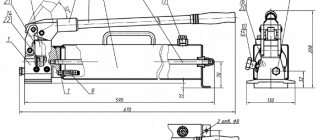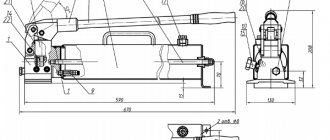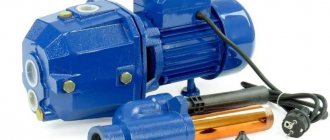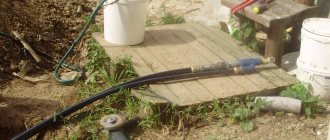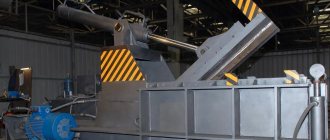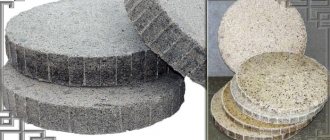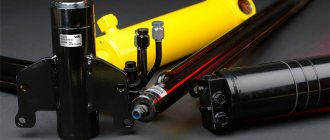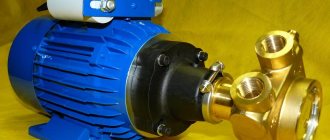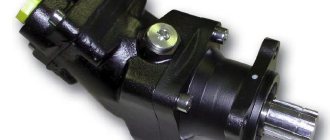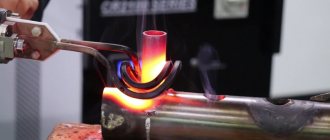Without exaggeration, the hydraulic press is one of the 100 greatest inventions of mankind. The appearance of such a machine was facilitated by Pascal’s law, which was formulated back in 1653. The first such device was patented by the English inventor, one of the founders of hydraulic engineering, Joseph Bramah, in 1795.
At first, the hydraulic press was used to lift heavy loads and obtain natural oils and juices, as well as form hay bales. Over time, the design of hydraulic presses has changed and modernized. Since 1820, the unit began to be used in the metalworking industry for pressing pipes. 55 years later, a stamp and a movable traverse appeared in the design, which contributed to the introduction of the technology into the military industry.
Thanks to the saving of metal, simplicity of design, speed of production and optimal performance, the press is widely used in the production of automobiles, marine vessels, aviation and agricultural equipment.
Varieties and characteristics
Main characteristics of a hydraulic press (parameters of each model are shown in the drawing):
- compression force (tons);
- handle force (Newtons);
- operating speed (millimeters per second);
- working stroke (centimeters);
- oil pressure in the hydraulic drive (Megapascal);
- drive power (kilowatts);
- dimensions and weight (millimeters and kilograms).
This range of parameters defines two types of drives:
- pump drive – does not use the principle of energy storage;
- pump-flywheel and pump-accumulator drives - use energy accumulation during periods between working strokes.
The service station uses different types of hydraulic presses: tabletop, vertical, electrohydraulic and pneumohydraulic (capable of developing a force of up to 100 tons).
According to the method of functioning, hydraulic presses are divided into two groups:
- automatic;
- manual.
Manufacturers make units with closed and open frames for working with elements of non-standard shapes. Based on the dimensions, there are desktop and floor-standing models. Depending on the bed, there are 2 types of presses: rack-mount and column-mounted. By type, two categories of devices can be distinguished: universal and specialized (special purpose).
Recommendations for use
In order not to encounter a situation where a manual hydraulic press requires repair after a short period of use, certain rules should be followed. First of all, it is necessary to pay attention to the correct installation of the press, focusing on the information provided in the accompanying document by the manufacturer.
Recommendations for operating a manual hydraulic press, which will avoid its frequent breakdowns and, accordingly, the need for repairs, are as follows:
- checking the working fluid level (this affects how much pressure the hydraulic cylinder can create);
- regular lubrication of moving and rubbing parts;
- checking the condition of sealing elements, which may lose their elasticity over time;
- checking the reliability of fastening the part during its processing.
Typical faults and methods for their elimination
When moving a manual hydraulic press, it is necessary to monitor the level at which the work table is located. This parameter is checked every time the pressing equipment is started.
Application and practical features of work
The wide range of power and design solutions of hydraulic presses allows them to be used for a variety of tasks: stamping, trimming, flanging, embossing, pressing, stitching, calibrating, bending, forging and even lamination.
Areas of use:
- industrial production;
- waste disposal (horizontal installations);
- repair of vehicles and special equipment;
- locksmith work.
Using such equipment, you can work with pipes and metal profiles, plastic and ceramic products, carbon and carbon-graphite electrodes, as well as produce rubber parts, cables, electrical insulating materials, various finishing and building boards and much more.
Features of various models:
- glycerin pressure gauges are characterized by increased accuracy, durability, vibration suppression and a wide measurement range;
- the winch mechanism is indispensable for adjusting the working surface;
- automatic rod return function significantly improves productivity;
- the safety valve will prevent excess pressure;
- chrome plated rod eliminates corrosion processes;
- modern units are equipped with progressive CNC.
In addition, the designs do not include various modules that protect against overloads, which has a positive effect on the price of pressing equipment. It is also noteworthy that the position of the moving table has no effect on the pressure value.
Content
To consider the design of a hydraulic press, we first define a hydraulic machine:
A hydraulic machine (from the Greek “hydraulikos” - water) is a machine whose operation is based on the laws of motion and equilibrium of fluids and is explained by Pascal’s law.
The hydraulic machine is based on two cylinders of different diameters, each of which has a piston (Figure 4). The cylinders are connected to each other by a tube and filled with liquid (water, oil, etc.).
Since these cylinders are communicating vessels, the height of the liquid column in them will be the same while the pistons are at rest.
Figure 4. Schematic representation of the operating principle of a hydraulic machine.
Now consider a situation where the pistons are acted upon by some forces $F_1$ and $F_2$, and $S_1$ and $S_2$ are the areas of the pistons. By definition of pressure, we already know that $p=\frac{F}{S}$, then:
Pressure exerted by the smaller piston: $p_1=\frac{F_1}{S_1}$
Pressure exerted by the large piston: $p_2=\frac{F_2}{S_2}$
Since the vessels are connected to each other, according to Pascal’s law $p_1 = p_2$ or $\frac{F_1}{S_1} = \frac{F_2}{S_2}$, which means that
$$\frac{F_2}{F_1}=\frac{S_2}{S_1}$$
The force acting on a piston is directly proportional to the area of that piston. Consequently, the force $F_2$ is greater than the force $F_1$ as many times as the area of the larger piston $S_2$ is greater than the area of the smaller one $S_1$.
For example, if the area of the large piston is $300 cm^2$, and the small one is $3 cm^2$, and a force of $100 N$ acts on it, then a force of $10,000 N$ will act on the large piston.
$$\frac{10,000 N}{100 N}=\frac{300 cm^2}{3 cm^2}$$
The exponential ratio $\frac{F_2}{F_1}$ is called the gain in strength . In other words , with the help of a hydraulic machine, a small force can balance a large force.
A hydraulic press is a hydraulic machine used for compression (pressing).
Hydraulic presses work effectively to convert small forces into large ones: they are used to compress seeds in the production of oil, for gluing building materials, for stamping jewelry. Modern hydraulic presses can produce hundreds of millions of newtons of force (Figure 5).
Figure 5. One of the most powerful hydraulic presses in the world.
Consider the design of a hydraulic press:
We complicate the design of the hydraulic machine: now there is a platform above the large piston 2, where we place the pressed body 1.
With the help of small piston 3, we create a large pressure on the liquid, which also begins to act on piston 2. This happens because the pressure is transmitted without change to each point of the liquid (Pascal's law).
The area of piston 2 is larger than the area of piston 3, therefore the force acting on it will be greater (the pressure is the same). Under the influence of this force, piston 2 begins to rise and presses the pressed body against the stationary upper platform.
A pressure gauge 4 is also installed here to control the liquid pressure and a safety valve 5 (automatically opens when the pressure exceeds the maximum permissible value in this device).
With repeated movements of piston 3, liquid again enters from the small cylinder into the large one: the small piston rises and valve 6 opens. The space under the piston is instantly filled with liquid. When the small piston 3 is lowered, valve 6 closes under liquid pressure, and valve 7 opens. So the liquid again ends up in a large vessel.
Advantages
Among the advantages of hydraulic presses, the main ones are:
- significant gain;
- the ability to implement different technological processes;
- high design reliability and safety;
- ease of work under a given mode;
- ease of control and low noise level;
- the ability to connect any hydraulic equipment to the drive (buckets, jackhammers, grippers, circular saws);
- speed and practicality.
Before purchasing such equipment, you should pay attention to the material of the frame structure, the quality of the seams, the presence of a return piston, the serviceability and reliability of the pressure gauge and hydraulic system, and also check the possibility of adjusting the height of the working area.
What is a hydraulic press?
A hydraulic press is a device that significantly increases the initially applied force. It is called a press conventionally, because in industry this apparatus is intended for the production of parts by stamping.
The most common example of a hydraulic press is a jack. A hydraulic jack allows a person to apply little effort but lift a heavy load. Brakes, shock absorbers, drives and pumps work the same way.
The hydraulic press gained popularity due to the fact that a huge flow of energy is transmitted through thin and flexible hoses, which further simplifies the work.
Design features of systems based on hydraulic cylinders
Technical systems, the functioning of which is ensured by a hydraulic cylinder, consist of the following elements:
- hydraulic cylinder;
- hydraulic motor;
- pump;
- emergency valve;
- container containing the working fluid.
Hydraulic diagram of the press (simplified)
The hydraulic cylinder itself consists of the following structural elements:
- housings;
- a piston rigidly connected to the rod;
- block cover, which is equipped with hydraulic equipment that allows you to control the operating parameters of the device.
The performance of a hydraulic cylinder-based system depends on a number of parameters:
- pressure level of the working fluid pumped by the pump;
- diameter of the piston working surface;
- volume of the working chamber of the device.
Hydraulic cylinders with flange mounting on the head side
The characteristics of the working fluid used are of great importance for the efficiency of the hydraulic cylinder:
- chemical composition and density;
- temperature limits at which the working fluid retains its original qualities;
- tendency to develop oxidative processes.
An important quality of the working fluid for a hydraulic cylinder, which you should pay attention to when choosing it, is the ability to retain its original characteristics when in contact with water (water can enter the hydraulic system from the outside).
As practice shows, in 70% of cases of hydraulic cylinder failure or incorrect operation, low-quality working fluid is used for the device. The result is increased wear of individual elements of the hydraulic system, the development of corrosion on the surfaces of metal elements, an increase in oil viscosity, its clogging with dust or dirt, and the appearance of water and air in its composition. Naturally, all such situations, the occurrence and development of which should be avoided, negatively affect the performance of the hydraulic system itself and its elements.
How to use a hydraulic press?
Each hydraulic press has design features, so the manufacturer sells the machine along with detailed operating instructions for the hydraulic press. But even after reading it, anyone who wants to work on it will not be allowed, because you need to know not only the instructions, but also the general rules on labor safety with hydraulic presses. Here are some of them:
- Only persons who have undergone instructions and a medical examination can operate the hydraulic press.
- You cannot work on a hydraulic press without special clothing.
- You should always be on the lookout for possible fluid leaks.
- Do not keep your hands near the work area.
- When finished, close the valve and wipe the tool.
More detailed guidance can be found in labor protection for working with hydraulic presses.
